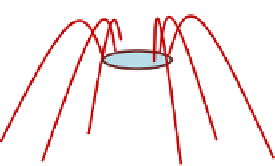Biomedical Engineering Reference
In-Depth Information
TABLE 2.2
Primary Subdivisions of Cellular Organisms that Have Been Recognized
Group
Cell morphology
Properties
Constituent groups
Eukaryotes
Eukaryotic
Multicellular; extensive
differentiation of cells and tissues
Unicellular, coenocytic or
mycelial; little or no tissue
differentiation
Plants (seed plants, ferns, mosses)
Animals (vertebrates,
invertebrates)
Protists (algae, fungi, protozoa,
slime molds)
Eubacteria
Prokaryotic
Cell chemistry similar to
eukaryotes
Most bacteria
Archaea
Prokaryotic
Distinctive cell chemistry
Crenarchaeota (sulfolobus,
therofilum, thermopteus,
pyrobaculum, haloquadratum
walsbyi)
Nanoarchaeota
Euryarchaeota (methanogens,
halophiles, thermoacidophiles)
Korarchaeota
information is contained in the DNA, whereas viruses can use either RNA or DNA to encode
such information. This nuclear material is covered by a protein coat called a capsid. Some
viruses have an outer envelope of a lipoprotein and some do not.
Almost all cell types are susceptible to viral infections. Viruses infecting bacteria are called
bacteriophages. The most common type of bacteriophage has a hexagonal head, tail, and tail
fibers as shown in
Fig. 2.3
. Bacteriophages attach to the cell wall of a host cell with tail fibers,
DNA-containing head
Collar
Sheath
Base plate
Ta i l f i b e rs
FIGURE 2.3
The structure of a typical bacteriophage.




















Search WWH ::

Custom Search